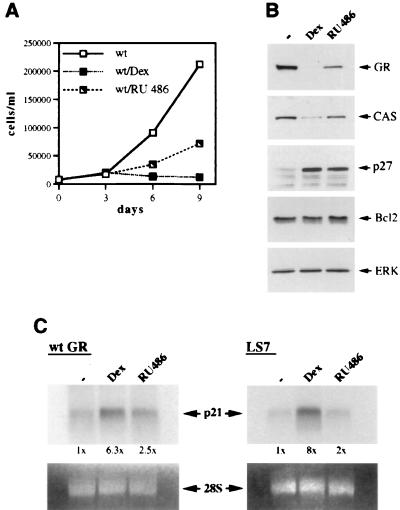FIG. 9.
Induction of CDI expression by the wt GR in SAOS2 cells is uncoupled by RU 486. (A) Differential effects of GR ligands on the proliferation of SAOS2-GR(+) cells. SAOS2-GR(+) cells were seeded on day 0 into six-well plates (20,000 cells/well) in duplicate and cultured in the presence of an ethanol vehicle, 100 nM Dex, or 100 nM RU 486. Total numbers of viable cells were determined on the indicated days. Note 69% inhibition of cell proliferation in the presence of RU 486, compared to 98% observed in the presence of Dex. (B) Alterations in protein expression induced by RU 486 in SAOS2-GR(+) cells. SAOS2-GR(+) cells were cultured in the presence of an ethanol vehicle, 100 nM Dex, or 100 nM RU 486 for 3 days, and expression of GR, CAS, p27, Bcl2, and ERK in whole-cell extracts was examined by immunoblotting. Note that comparatively mild repression of GR and CAS is observed in the presence of RU 486, whereas p27 induction is retained whether GR is activated with Dex or RU 486. Similar results were obtained with RU 486 concentrations of 500 nM and 1 μM (data not shown). (C) RU 486-activated wt GR or LS7 mutant fails to efficiently induce p21 mRNA expression in SAOS2 cells. SAOS2-GR(+) (wt GR) and SAOS2-LS7 (LS7) cells were treated with an ethanol vehicle, 100 nM Dex, or 100 nM RU 486 for 2 h 30 min, and total RNA was isolated and subjected to Northern hybridization with a 32P-labeled p21 cDNA probe (top panels). Equal loading in each lane is demonstrated by ethidium bromide staining of 28S rRNA (bottom panels). The results of autoradiography were quantitated by spot densitometry. The densitometric value obtained for mock-treated SAOS2-GR(+) or SAOS2-LS7 cells was arbitrarily set as 1×.

